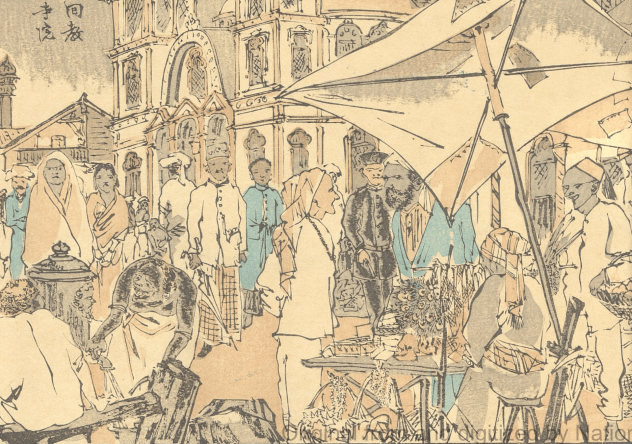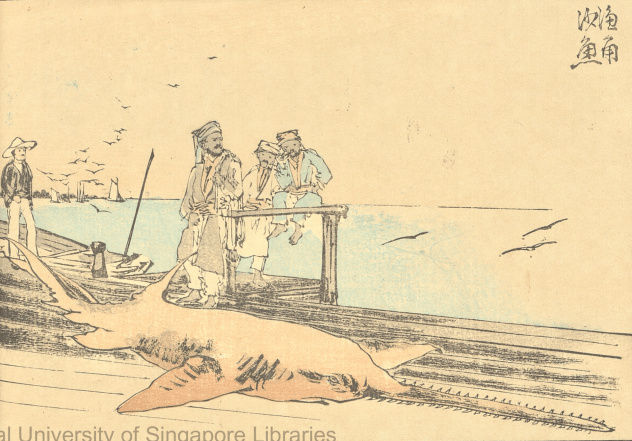By Tim Yap Fuan
Kubota Beisen (1852-1906), born to an innkeeper, had a knack for drawing from a young age. Despite his father’s hopes for him to take over the inn, Beisen pursued his artistic passion. Initially discouraged by his father, who even tossed his art materials into a river, Beisen was allowed to pursue his artistic inclinations when his health began to decline.
At the age of 16, Beisen started learning from Kyoto painter Suzuki Hyakunen and later formed a close bond with Kono Bairei. Although he received guidance from these artists, Beisen is often regarded as mostly self-taught, known for his distinctive blend of Japanese style with Western influences.
Supporting himself through designs for export, Beisen gained recognition as an artist and joined the Kyoto Prefectural Art School in 1878. In 1886, he co-founded the Kyoto Young Painters Study Group with Bairei.
Beisen’s artistic journey took him to France in 1889, where he earned a gold medal at the Paris Exposition – a well-deserved recognition of his talent and standing as an artist. The creative outcome of this journey in which he stopped at places like Shanghai, Hong Kong, Annam (now Vietnam) and Singapore was a two-volume work, Beisen’s Travel Album published in the same year. Despite spending only 8½ hours in Singapore, Beisen produced nine double-page and three single-page drawings, showing places like High Street, Pulau Brani, Telok Ayer, and the Botanic Gardens as well as depictions of various plants and animals. Through his woodblock prints, Beisen offered a detailed snapshot of the city at the close of the nineteenth century. Below, you’ll find a more in-depth description of some of his prints depicting Singapore:
Steam tram amidst the hustle and bustle of High Street
The steam tram service in High Street, Singapore, was introduced on 1 January 1886. This service marked the beginning of tram transportation in Singapore. Operated by the Tanjong Pagar Dock Company, the steam tram provided a mode of transportation in the area. Besien observed in his notes that the service operated at 15-minute intervals. The service was eventually replaced by electric trams in 1905 operated by the Singapore Electric Tramways Company. However, the tram service was discontinued in 1927 and replaced by buses as the primary mode of public transportation in Singapore.
An unidentified mosque
This print beautifully depicts the vibrant atmosphere of a bustling street, framed by an unnamed mosque with architecture showcasing elements of the Indo-Saracenic style. This picturesque scene could easily be situated in Little India, with speculation that the mosque in focus might be the Abdul Gafoor Mosque.
Sawfish
Significantly, his depiction of a large sawfish is recognized as the earliest representation of the species in Singapore, attracting particular attention from biodiversity history researchers. An undersea telegraph cable between Penang and Singapore, which was laid in December 1870, ceased relaying messages in March 1871. The fault, discovered and repaired in June, was exceptionally peculiar — the damaged part appeared to have been bitten by a fish. Mr. Buckland, in possession of the damaged section, was thoroughly puzzled. During his museum rounds one day, he observed the beak or saw of a sawfish with intense interest, realizing that this was the creature responsible for the hole in the telegraph cable. Subsequent tests led him to the conclusion that a large sawfish had caused the damage. This captivating anecdote is recounted in Chambers’s Journal of Popular Literature, Science, and Arts, volume 52, page 804, 1875.
Botanic gardens
And my personal favourite: Beisen’s double-page print of the botanic gardens, bathed in an array of green hues, imparts a timeless beauty amid a tranquil and transparent stillness.
Upon his return, he co-founded the Kyoto Fine Art Association, worked as a newspaper artist in Tokyo, and attended the World’s Columbian Exhibition in Chicago in 1893.
Beisen’s influence reached beyond Japan, leaving an impression on American artists like Robert Henri and John Sloan during his visits to the United States. Henry P. Bowie, an American artist who studied under Beisen, praised him as one of Japan’s most popular and gifted artists.
In 1894, Beisen and his sons served as war correspondents and illustrators during the Japanese army’s conflict, producing illustrations that gained immense popularity. His return to Japan was marked by an exceptional honor: a summons by Emperor Meiji to draw pictures in his presence, a rare acknowledgment of an artist’s high standing in Japanese society.
Rare copies of the revered artist’s tourbook Beisen’s Travel Album are now in our collection, preserved in both physical and digitised format.






Such a lovely collection, thank you for sharing!